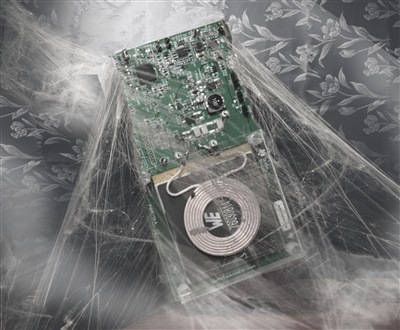
Did you know, the Centers for Disease Control and Prevention has a web page from the Office of Public Health Preparedness and Response to address zombie preparedness. They claim that it is tongue in cheek, but we all know better.
Here’s a horrifying thought, what happens when things go south and the zombies start roaming? How will I keep my personal electronics (phone, tablet, watch and others) charged? What if I’m attacked and get zombie brain matter all over my USB connectors? As part of my zombie apocalypse preparedness measures, I’ve started stocking up on spare rechargeable batteries and buying wireless powered devices whenever I can.
The Wi-Fi®, LTE and Bluetooth® in my valuable electronics will transfer data through the gore, but, their batteries need to be recharged too. But, how do I get a decent charge? That’s where wireless power comes in. As long as my home base is safe, I can keep my power transfer going. After wiping away whatever gets on my phone I can place it on the charging pad and get a full recharge.
I’ve even taken the liberty of modifying some of my important electronics to add wireless power. Monitoring my healthy activities can’t stop just because of a zombie or two. I’ll need to keep my fitness tracker running. Gotta keep that heart rate monitored. And what about playing a game or two on my favorite app? What does wireless power have to do with this? I’ve seen enough of the movies to know things can get very messy. I need the Bluetooth® speaker to either broadcast my personal theme song, or find out what tunes drive the zombies mad. Yes, I’ve thought about this a lot.
While I prefer to buy the devices with wireless power built in, there are after-market products that supply wireless power. I also create my own wireless powered electronics. I start with the receiver portion, where I have several good choices. TI’s bq51222 is a great multipurpose solution. It’s fully certified to the latest Wireless Power Consortium (WPC) v1.2 and Power Matters Alliance (PMA) standards. With the adjustable output voltage feature, I simply adjust the output to the desired voltage (generally 5V for USB, but you can set it up to 8V). To keep the USB option available after I add wireless power, I add a simple dual FET like the CSD75207W15 NexFET™ power MOSFET between the USB input supply and the bq51222 output. This prevents any power contention if I’ve got both USB power and wireless power active at the same time.
Other options include the bq51013B (another 5W solution) or the bq51003 for the smaller wearables requiring less than 2.5W. For higher powered solutions (tablets and some fast-charging phones), I like the bq51025 since it is fully Qi-certified at 5W and can also deliver 10W when paired with the right transmitter.
Speaking of transmitters, for the 5W, I like the bq500511A and bq50002A two-chip solution due to its small BOM count. The newly released bq501210 15W transmitter is WPC v1.2 certified. . It works with all 5W Qi-certified receivers, will get that 10W out of the bq51025 and can deliver 15W with the right receivers. There are several TI Designs that can help you on the wireless power learning curve. The E2E™ Community Battery Management forum is a great way to get detailed design help from experts on TI’s entire product portfolio.
Last, but not least, if you’d like to hear about how to get your batteries fully charged in the quickest time and how to make sure your battery powered taser has full capacity, let me know in the comments below.
Additional resources:
- Check out the 15-W wireless power transmitter.
- Read more wireless power blogs.
- Learn more about wireless power.
